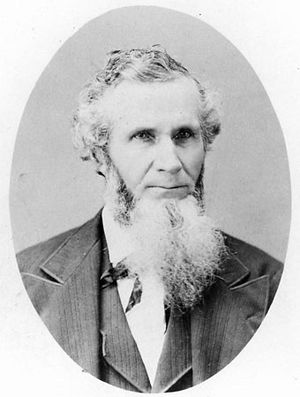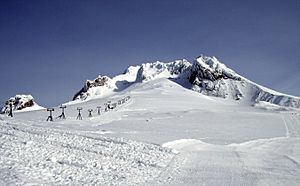Joel Palmer facts for kids
Quick facts for kids
Joel Palmer
|
|
|---|---|
 |
|
| 3rd Speaker of the Oregon House of Representatives | |
| In office 1862–1863 |
|
| Preceded by | Benjamin F. Harding |
| Succeeded by | Isaac R. Moores Jr. |
| Personal details | |
| Born | October 4, 1810 Elizabethtown, Ontario, Canada |
| Died | June 9, 1881 (aged 70) Dayton, Oregon, U.S. |
| Political party | Democrat, later Republican |
| Spouses | Catherine Coffee m. 1830 Sarah Ann Derbyshire m. 1836 |
| Profession | soldier, pioneer, businessman |
Joel Palmer (born October 4, 1810 – died June 9, 1881) was an important American pioneer in the Oregon Territory. This area is now part of the Pacific Northwest in the United States. He was born in Canada and spent his younger years in New York and Pennsylvania. Later, he served as a representative in the Indiana House of Representatives.
In 1845, Palmer traveled to the Oregon Country. He helped create the last part of the Oregon Trail, called the Barlow Road. He worked with Sam Barlow and others. Palmer is famous for climbing high on Mount Hood to find a path when his group got stuck.
He wrote a popular guide for people moving west. He also helped start the town of Dayton, Oregon. Later, he worked as an administrator for Indian Affairs, which was a bit controversial. After Oregon became a state, Palmer served in the state's government. He was even chosen as the Speaker of the Oregon House of Representatives in 1862. In 1870, he tried to become Governor of Oregon but didn't win.
His old home in Dayton, the Palmer House, was added to the National Register of Historic Places in 1987.
Contents
Joel Palmer's Early Life and Family
Joel Palmer was born in Elizabethtown, Ontario, Canada, on October 4, 1810. His parents, Hannah Phelps and Ephraim Palmer, were Quakers from America. When Joel was two, his family moved to New York's Catskill Mountains because of the War of 1812.
He only went to elementary school for three months. In 1822, when Joel was 12, he became an indentured servant for four years. After this, he moved to Bucks County, Pennsylvania, to work on canals and bridges.
Joel married Catherine Coffee in 1830, but she passed away after childbirth. On October 8, 1832, Palmer became a citizen of the United States. He married his second wife, Sarah Ann Derbyshire, in 1836. They bought land near Laurel, Indiana, where he managed a canal building project.
In 1843, he was elected to the Indiana House of Representatives as a Democrat. He represented Franklin County and was re-elected in 1844.
Joel Palmer: An Oregon Pioneer
In the spring of 1845, Palmer traveled to Oregon without his family. He was the captain of a wagon train with 23 wagons. Stephen Meek was their guide. Meek left the group at Fort Hall to lead some people on a different path called the Meek Cutoff.
The rest of the wagon train reached the end of the Oregon Trail at the Columbia River. They didn't want to wait for transport down the dangerous Cascades Rapids. So, Palmer's group joined Sam Barlow's group. They wanted to find a way through the Cascade Range around the south side of Mount Hood.
On October 7, 1845, Palmer climbed to 9,000 feet on Mount Hood. He had little food and only moccasins for protection. He was scouting a route off the mountains. This was the first time anyone recorded climbing Mount Hood. The Palmer Glacier on the mountain is named after him.
Winter was coming, so the groups had to leave their wagons on the mountain's eastern side. Palmer rode on horseback to Oregon City. Barlow and Rector walked to Oregon City, blazing a trail. Sam Barlow later returned with Philip Foster to build the Mount Hood Toll Road, which became known as the Barlow Road.
In 1846, Palmer went back to his family in Indiana. In 1847, he published his diary as Palmer's Journal of Travels Over the Rocky Mountains, 1845–1846. This book gave advice on what equipment to bring and detailed route information for the Oregon Trail. It also described the Oregon Country and the Willamette Valley. It was a very popular guide for immigrants for the next ten years.
Also in 1847, Palmer and his family traveled to Oregon. He was the captain of the main wagon train that year. In the Walla Walla Valley, he met Marcus and Narcissa Whitman at their mission. This was shortly before they were killed in the Whitman massacre. This event started the Cayuse War.
Perhaps because he met the Whitmans, Palmer later became a peace commissioner. He helped negotiate with tribes who were thinking about joining the Cayuse in the war. When the war began, he was made the commissary-general for the Provisional Government’s army.
After the war, in 1848, Palmer joined the California Gold Rush. But he returned in 1849 to help start Dayton, Oregon. He built a sawmill on his land claim near the lower Yamhill River.
Joel Palmer: Oregon Politician

In 1853, President Franklin Pierce appointed Palmer as the Superintendent of Indian Affairs for the Oregon Territory. There were many ideas about what to do with Native Americans. Some wanted them to join society, others wanted them completely removed.
Palmer was good at negotiating "Cessation of Hostility treaties" with Native tribes in 1854 and 1855. He helped create nine out of fifteen treaties. He worked with Isaac Stevens, who was in charge of Indian Affairs for the Washington Territory. Together, they had a successful Walla Walla Treaty Council during the Yakima Indian War. About 5,000 Native Americans attended these discussions from May 29 to June 11, 1855.
Palmer became unpopular with some settlers, newspapers, and officials. They thought he was too kind to the Native Americans. However, he moved tribes to reservations outside the Willamette Valley. He wanted to prevent problems between settlers and Native people by keeping them separate.
In late 1855, he was moving the Rogue River tribes to the Grand Ronde Reservation. Some settlers threatened violence because they felt the land should not be given to the tribes. Palmer succeeded in moving them. But the territorial legislature asked for him to be removed from his job. He left office in 1857.
After leaving his job as Indian Affairs Superintendent, Palmer worked on his farm. He also ran his sawmill and other businesses. Between 1858 and 1861, he spent time in British Columbia. He was a merchant selling goods to gold prospectors in the Thompson River, Similkameen Valley, and Fraser River areas. In 1860, Palmer found a route to the gold fields of the Okanogan Valley and the upper Columbia River.
In 1862, he was elected to the Oregon House of Representatives for Yamhill County. He was now a member of the Republican Party. He was chosen as Speaker of the House during that session.
That same year, Palmer started the Columbia River Road Company. This company aimed to build a trail through the Columbia River Gorge on the Oregon side. In 1864, Palmer was elected to the State Senate. He served there until 1866. This included a special session in 1865 when Oregon adopted the Thirteenth Amendment to the United States Constitution. This amendment ended slavery across the United States.
He ran for governor in the 1870 election as the Republican candidate. However, he was narrowly defeated by La Fayette Grover. Many believe this was because of his past policies regarding Native Americans.
Treaties Joel Palmer Negotiated
- Treaty with the Rogue River, 1853
- Treaty with the Umpqua–Cow Creek Band, 1853
- Treaty with the Rogue River, 1854
- Treaty with the Chasta, etc., 1854
- Treaty with the Umpqua and Kalapuya, 1854
- Treaty with the Kalapuya, etc., 1855
- Treaty with the Wallawalla, Cayuse, etc., 1855
- Treaty with the Middle Tribes of Oregon, 1855
- Treaty with the Molala, 1855
Joel Palmer's Later Years and Legacy
Joel Palmer's brother, Ephraim, also moved to Oregon. He served as a captain in the first regiment of the Oregon Infantry. In 1871, Joel was the state's Indian agent for the Siletz tribe. He stayed in this role until 1873. All eight of Palmer's children went on to complete higher education.
Joel Palmer passed away in Dayton on June 9, 1881, at 70 years old. His former home, the Palmer House, was built in 1852. It was added to the National Register of Historic Places in 1987 and now operates as a restaurant.
Palmer's name is one of 158 names honored in the frieze of the Oregon State Capitol building. His name is in the Senate chamber. During World War II, a liberty ship called the SS Joel Palmer was built and named after him.
The Oregon Historical Society gives out the Joel Palmer Award. This award is for the best article published each year in their quarterly magazine, Oregon Historical Quarterly.


